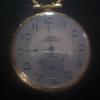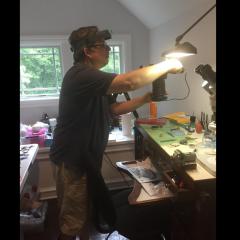Leaderboard
Popular Content
Showing content with the highest reputation on 07/26/16 in all areas
-
Since I was working on the Landeron 48 with wrong dial, from which I used the case and a Landeron 151 and correct dial to make a new watch, I saw this Landeron 248 sitting in the drawer at my desk and devided to finally tackle the issue it had: a slipping mainspring. I documented the disassembly of the movement vith 3 videos, the first of which is here below: Hope you enjoy1 point
-
"10, 9, 8, 7, 6, 5, 4... take a deep breath and exhale." Ok, I've calmed down, stopped swearing and I promise not to punch and walls. Mainspring, my mortal enemy why do you keep taunting me?! I feel fairly confident when it comes to disassembling and assembling any type of watch (not including chronos yet). But when I sit staring at that mainspring barrel a voice always whispers in my ear "- Let it be. It's probably fine. No need to disturb what need not be awaken." But I always ignore that voice, I'm a capable man after all, right? Oh the lies, the lies I keep telling myself.. I have acquired a set of three K&d mainspring winders type 123. They usually do the trick when it has come to old Hamilton movements such as the 980, 770 etc. The t-end mainsprings found in these movements are easy enough to reinstall with said winder (most of the times anyway). Automatics however, seems to be a different beast entirely. I have in the last week completely destroyed two mainsprings while trying to restore a Seiko Sealion. I mean, what's the problem? What is so different with the automatic mainsprings? You hook it up, roll it in, and pop it out in to the barrel. But no no, these mainsprings does not want to play ball. They twist and turn and eventually explode. Is anybody else using similar winders with automatic mainsprings? If so, how do you get it to work? What am I missing? Or should I just leave the mainsprings be? Only open Pandora's box when I know it's broken? What do you suggest? Here's the mainspring flower I picked this morning.1 point
-
The ETA is not really indispensable, the regulator pin turns easily with tweezers. Also, is used for positional adjustment, but you have to eliminate beat error first. If you have less that 15 s/d positional variance don't even bother messing with it.1 point
-
Seems like you did a good job. Note the lines are deceiving , the watch is not in beat is off of 5.8 ms, a value that makes lines overlap (it happened to me too), so you have to move the end stud arm. The pattern is excellent and I wouldn't worry too much about the amplitude, after all you're running with an intervened HS.1 point
-
Don't know if I am allowed, but check out the following: http://www.timekeeperforum.com/forum/threads/adjustment-and-regulation.21105/ The lines are not quite straight (but this is not a new watch) and the amplitude is a bit low (maybe the mainspring is tired).1 point
-
Trust me the spring won't jump. You only have to be careful placing the first coil, all the rest is straightforward. Seiko barrels have their own sizes and you many not find a winder that fits perfectly.1 point
-
I don't know about winders but if you place the spring into the barrel, and go around holding the coils in place with the flat of the tweezers, possibly using finger coats in the right hand, it will go in without much effort.1 point
-
I have not encountered that issue. I find as you wind the spring you have to un-twist sometimes especially as it gets towards the end of it,s length. Winding by hand I always found difficult & if wearing finger cots the finger cot would try and get in on the act so I just purchased the winder.1 point
-
I always wind by hand as I have no winders but please remember to wear your cots or like me latex gloves hand grease and oil doesn't like main springs.1 point
-
Clear lacquer is what you need. That's what is used on French Carriage clock cases if there not gilded. Use a very fine artists paint brush.1 point
-
I used to pull every spring out of its barrel, clean then refit by hand, as I could never afford the tools at the time, and didnt ever have any issue, even with auto-springs--Except one time- A Smiths Enfield Clock-spring got away from me during installation and slashed my finger open quite badly down to the bone... Havent done one for years, as I tend to collect Accutrons now so no Dangerous Mainsprings!...1 point
-
I have that style of winder + a Bergeon style the same as Mark uses. I found that with both of these winders the issue is releasing the arbour once wound. If the spring is a bit tight around the winding arbour then if not careful it will pop the spring out with the flower. I found what really helps is to give the winding arbour a thin coating of either barrel grease or Vaseline. Then this really helps when removing. Also slowly does it I have a very thin pair of tweezers that I use to keep poking the centre of the spring back as it tries to pop out when releasing.1 point
-
1 point
-
1 point
-
I can't help on the auto mainspring issue, pretty sure someone here will help. Just wanted to say your humor is spot on!1 point
-
1 point
-
1 point
-
BTW I cancelled my order. I noticed it says "complete calendar" but there isn't any, that's is intolerable for $22 chronograph No, really i did it because it has too many index rings, but I'm soon buying a Chinese watch without a doubt.1 point
-
You don't, but the story that follows about an Omega which had troubles has nothing to do with fakes ?!? And the money count that you made seems to justify the idea that "playing the system" is right just because the original is so expensive. Once again, if you we're talking about generic Chinese watches, including the A7750 mentioned in another thread at $22, there would be no problem. No snobberish. It is when it comes to counterfeiting and fraud that people rightly gets irked,1 point
-
See the section "How to Set a New Roller Jewel" in the Bulova manual here: http://www.mybulova.com/sites/default/files/file/Joseph Bulova School of Watch Making - Unit 10a.pdf You can see an image of the roller being held by the tool. You will notice that your tool also has some curved recesses in the end piece that will make it easier to hold the round table securely. In the book they show the repair with the table still attached to the balance. I prefer to remove the table from the balance in order to avoid getting shellac on the balance. Also, removing from the balance gives access to the underside of the table. Have a look at the video that Geo linked above as well for tops on the technique. Although Mark does not use the same holder, the rest still applies. Best of luck!1 point
-
Where there are mega-overpriced luxury items--There'll be fakes. Thats just the way of the world. I don't defend or condone this--Its just the way it is! What surprises me is the Huge amount of Snobbery concerning this in the Horological world. Even the cheapest and cruddiest Fake is still a Real Wristwatch. For such like of Omega, Rolex and Breitling, what you're paying for is the Advertising, Sponsorship deals etc and all that to persuade you to buy the things in the first place! Leaving heritage aside for a second think of this- Gen Breitling Navitimer, Cost of Manufacture,assuming an ETA movement etc Around £5-700, cost to buyer, £5,000+ Fake Breitling Navitimer (top of range superfake, A7750, Noob or JF etc) Cost of manufacture, Around £150-200. Cost to buyer, £3-400 True, the after-sales is good for Gen watches and non existent for the fakes, but reliability is probably much the same these days. In the late 60's my father bought a gen Omega Speedmaster MkII, (Omega-861 if I remember right, with a flat glass crystal)-- Nice watch. It went back under guarantee twice as the timer functions caused it to stop. This was never completely resolved and it went for various services back to Omega and the dealer-network, Even returned to Switzerland once over the following 10 years or so. He was without the thing for more time than he had it, the turn-around time was terrible! He got fed up trying to get it repaired, at Huge cost I may add, and just used it as a watch, never using the timing functions, as the best it would do is keep running but lose time badly. It was eventually repaired it in the late 70's- early 80's when I did a full service to it myself at the age of just 15, where it ran perfectly for years, all with nothing more than basic tools cleaning-fluids and inexpensive watch-oil.- -Thinking back now, I was a Crap watch-repairer, but sorted this out where Omega and its whole dealer repair network couldn't over 10 years! Who is really doing the rip-off....1 point
-
That is probably google translate that has translated the text. I think it means? Don't adjust the time when the hands between 22 -3 a clock. That could break something?1 point
-
The second part of the video is finally ready: Enjoy... The third and final part will be uploaded in a few days.1 point
-
Actually, that's a great guideline for anything we do for others that has a potential for going horribly wrong. And based on this, I will decline to repair these two items, so thanks for the very sound advice.1 point
-
The key point here is that this watch is not yours; it belongs to a friend. I recommend you not attempt any repair unless you give him an explicit disclaimer that there is a high risk that you will leave the watch in worse condition that it is now. Only if he accepts that should you proceed. If his considered options are your amateur repair versus discarding the watch, he may ask you to do the attempt. If he has any emotional or financial investment in the watch, he should not. In fact, if you discern that he has either of those, you should decline the invitation to repair the watch, since he and you may both come to regret an attempt even if he has accepted your disclaimer. --Eric1 point
-
1 point












